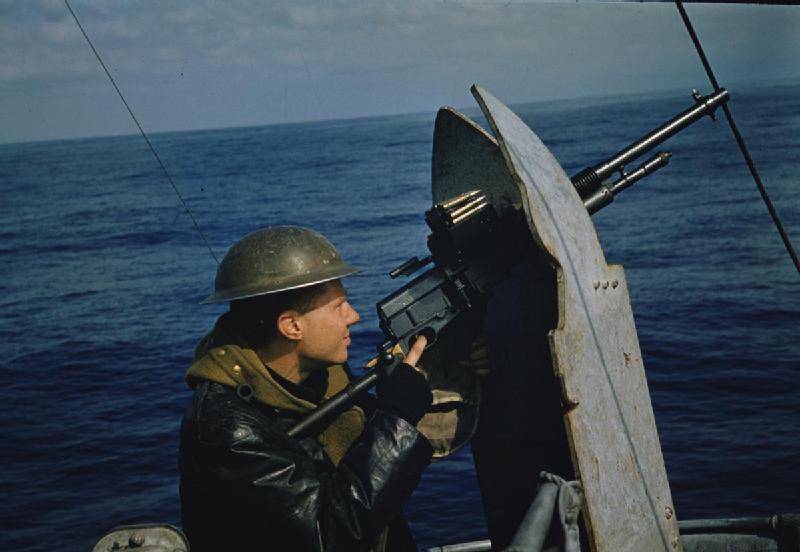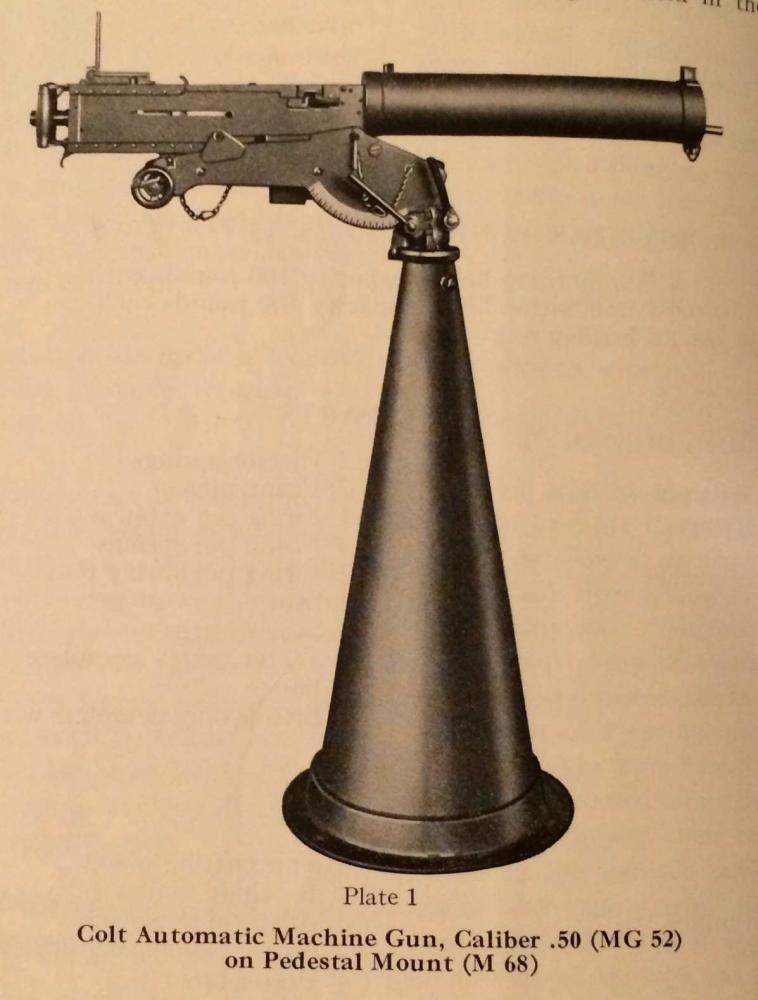_20211209_0936405717.jpeg)
TYPE: ex whaler/guard boat/Minesweeper
OLD NAME: STAR XII
PREVIOUS OWNER: Hvalfangerselskapet Blaahval A/S, Sandefjord
BUILDING SITE: Nylands Værksted, Kristiania (Oslo), Norge
LAUNCHED: April 1929
IN COMMAND: 1939 - 07.1945
WAR OPERATIONAL: 27.12.1940 In Great Britain
ARMAMENT
Spoiler
-
1x 3" Fast Firing Cannon
-Caliber in metric: 76.2mm
-Barrel length in calibers: L/50
-Placement: Bow -
1x 37mm Pom Pom AA Cannon

-Placement: Aft of the vessel -
2x .303 Hotchkiss machineguns

-Placement: 1x on each brigde wing, wich on Hval V is a little in the front of the wheelhouse
-Armor: The mg’s did later in the service get armored shields, most likely simlar to the one in the picture
-Mass: 12 kg
-Length: 1.23 m
-Barrel length: 64 cm
-Cartridge: .303 British (Britain)
-Action: Gas-operated
-Rate of fire: 400-600 rounds per minute[1]
-Maximum firing range: 3800 m
-Feed system: 30-round feed strip, or belt-fed -
1x2 .303 Twin Lewis machinegun

-Placement: Uncertain, possibly in the spot right behind the chimney, where usually have been mounted single mg’s
-SIghts: air type -
1x 12.7x99mm Colt MG/52 Machinegun

-Cooling system: Water cooled
-Placement: Uncertain
Minesweep
-LL III
-SA Gear Type A Mk.II
-Spring hammer Mk.II
TECHNICAL DATA
Displacement: 284 Gross tonnage
Length: 35.05 Meter
Width: 7.07 Meter
Depth: 4.02 Meter
MACHINERY
1x Triple expansion Nyland steam eigne
3-cylinder diameter: 13.8"-22"-37.5",
Stroke: 24"
1x main steam boiler (fire tube boiler)
Dimensions: 14’ x 11’, 3 fireplaces, oil fired.
Heating Surface (HF): 2,253 sq/ft, 200 PSI.
Power: 750 Indicated Horse Powers
Speed: 10 knots (18.52 Km/h)
Range : 5000n. miles at 8 knots (14.81 Km/h)
CREW
Estimated crew: 19 Men
HISTORY
Spoiler
The Norwegian Navy’s previous experience in demining was only neutralizing drift mines during and after the First World War. These were isolated cases, because no minefields had been laid out in Norwegian territory. It was not until the early thirties that it was realized that this could become relevant. It was therefore decided to equip six decommissioned Class 2 torpedo boats as combined guard boats and minesweepers. The torpedo guns of these vessels were taken ashore, and on a platform aft an arrangement was set up for Oropesa sweep. Incidentally, there is very little information about the equipment on these vessels. The Oropesa sweep was developed by the Royal Navy during the First World War and was named after the trawler Oropesa which first tried this type of sweep.
The Oropesa sweep, or O sweep as it is also called, consists of a cable or wire that the vessel releases. An otter is attached to the end of the cable, which causes the cable to pull outwards from the vessel. To mark where the otter is, there is a float on the surface, called a Paravan. Along the cable there are knives that will cut the anchoring of any mines so that they float up and can be neutralized. Another otter is attached to the inner side of the vessel, so that the sweep cable cuts into the water. The system is the same as on a trawl. The O-sweep, which is operated by one vessel, was a necessary further development of the English A-sweep. This consisted of a cable, pulled between two or more vessels. During an attack, it was very difficult to maneuver with the A-sweep in the sea. The growing threat of war and thus the danger of minelaying in Norwegian waters meant that, in addition to the rebuilding of the 2. kl. torpedo boats, it was decided to build two minesweepers. These, OTRA and RAUMA, were built at Akers mech. Workshop and were completely new and fully equipped when Great Britain announced that they had laid mines at Stad, Hustadvika and Landegode north of Bodø in April 1940. OTRA and RAUMA were in Horten and had received orders to go to Western Norway to clear the minefields, but was instead involved in the fighting at Horten harbor after the German attack on 9 April. OTRA was, following reports of foreign warships in the Oslofjord, sent out to observe and was able to 04.10 report that these vessels were German. RAUMA joined OLAV TRYGGVASON in battle with the German Raumboot R.17 and R.27 at Horten harbour. R.27 fired at RAUMA and badly damaged the vessel. The Chief, Itn. I. K. Winsnes, and one deckhand was killed and six others wounded, OTRA became the Germans’ prey at the quay at Filtvet, was named TOGO and was used as a guard boat until the navy got it back in 1947. Then OTRA was converted into a training vessel for minelaying.
It was after the rebuilding of the guard boats Bjerk, Syrian, Børtind, Nordhav II, Thorodd and Hval V that the navy got to try its hand at minesweeping duty in Great Britain. These were the vessels that made it over to Great Britain after the fighting in Norway ceased in June 1940. In addition to these, the navy took over its first vessel from the Roy Navy. It was the trawler ALCMARIA, equipped as a minesweeper and under Norwegian command from 15 October 1940 to 28 November 1944. The next minesweeper taken over from the Royal Navy was actually Norwegian. The whaleboat POLAR VI was requisitioned by the Royal Navy as early as March 1940 and transferred to the navy in February 1941. The minesweepers were first stationed in harbor towns on the east and north coast of Scotland. Later, it became most practical to gather the Norwegian minesweepers in a separate Norwegian minesweeper division, which had its station in Dundee.
IN COMBAT
On 13 April, three planes came into Måløy. These had been fired upon over Vigra and had to make an emergency landing at Gangsøy. One, however, managed to take off again, but had to go down near Berle in Frøysjøen. The aircraft were of the JU 52 type, a combined passenger and transport aircraft, produced at the Junkers factories. The planes could be equipped with both floats and wheels. More than 5,000 such aircraft were manufactured before and during the war. They usually had room for 15-17 passengers. These three planes had been in Trondheim with troops and were on their way back to Sylt in Germany. Hval V immediately went out from Måløy towards Gangsøy. This could be risky as both aircraft were equipped with three machine guns and Hval’s gun crew had no protection against machine gun fire. They also had to, in case they were to shoot, take into account the houses on land. But nothing happened, and Jacobsen ordered a boat on the water and the telegraphist rowed over with orders for the pilots and crew to surrender.
They refused at first, but then one driver joined back to “Hval V”. During the interrogation, the German laughed derisively and asked if they didn’t know that the whole area was full of German forces, including a submarine. Captain Jacobsen had no guarantee that this was not true, and he therefore decided to open fire on the planes. He first fired a warning shot, so that the Germans ran ashore on Gangsøy. He then scored a perfect hit that set the planes on fire. One of the Germans was slightly wounded by shrapnel, while the rest were unharmed. Hval V now set course for Måløy to hand over the German prisoner. On the way in, they met the fishing boat “Bergholm” of Måløy, which was later incorporated into the fleet of Shetlands-Larsen, with the guard on board. These were ordered to pick up the aircrew on Gangsøy, while the one prisoner was left in the sheriff’s custody in Måløy. Hval V now headed for Berle where the third plane had landed. As they approached, the aviators standing on land caught sight of them. They jumped on board the planes and tried to take off. Hval V immediately opened fire, and scored a full hit before they got up to speed. The fliers sprang ashore again, and were captured by some farmers who came from nearby farms. They were then taken on board and transported back to Måløy. The prisoners from Berle and Gangsøy, ten in all, were all lodged in the field hospital for the night, and on 14 April were sent to Nordfjordeid with the guard corps as escort.
On the same Sunday, Hval V returned to both Gangsøy and Berle to collect equipment from the three aircraft. These were parachutes, life jackets, rubber boats, eight machine guns with ammunition, three engines and some revolvers. The machine guns and revolvers were distributed between Hval V, Bergholm, Gruppesentralen and the guard corps.
On Tuesday 16 April, the guard corps came on board and mounted shields on the cannon, mounted machine guns and built breastworks on the bridge.
On 19 April, while Hval V was in Måløy, a German plane came at high altitude from the south, but then dived and came in towards the harbor at low altitude from the north. The plane dropped two bombs against the Danish ship “Flynderborg”, and one man was killed and six men wounded. These six were connected at the field hospital in Måløy and then sent to the hospital in Nordfjordeid. Hval V was machine-gunned from the aircraft. They failed to return fire with the cannon, but answered back with machine guns. No one was injured.
DRAWING OF THE VESSEL
Drawing of “Hval V” from the book Catchers and Corvettes; The Steam Whalecatcher in Peace and War, 1860-1960. now this is just a drawing of it, but it shows how the vessel looked and briefly where the guns were placed.
SIMLAR MODEL

This is not HNoMS Hval V, but it is very simlar. I am goint to travel to the Navy Museum in Horten one day, and hopefully they will have models of this vessel and others.
ALBUM
Spoiler
SOURCES
Spoiler
Nasjonalbiblioteket
Redirecting...
Norske Marinefartøy – Bodoni Forlag
Leselystig 39: Modeller som forteller – Norsk Marinehistorie | Polar Coordinate
Nasjonalbiblioteket
D/S Hval V - Krigsseilerregisteret
- Yes
- No